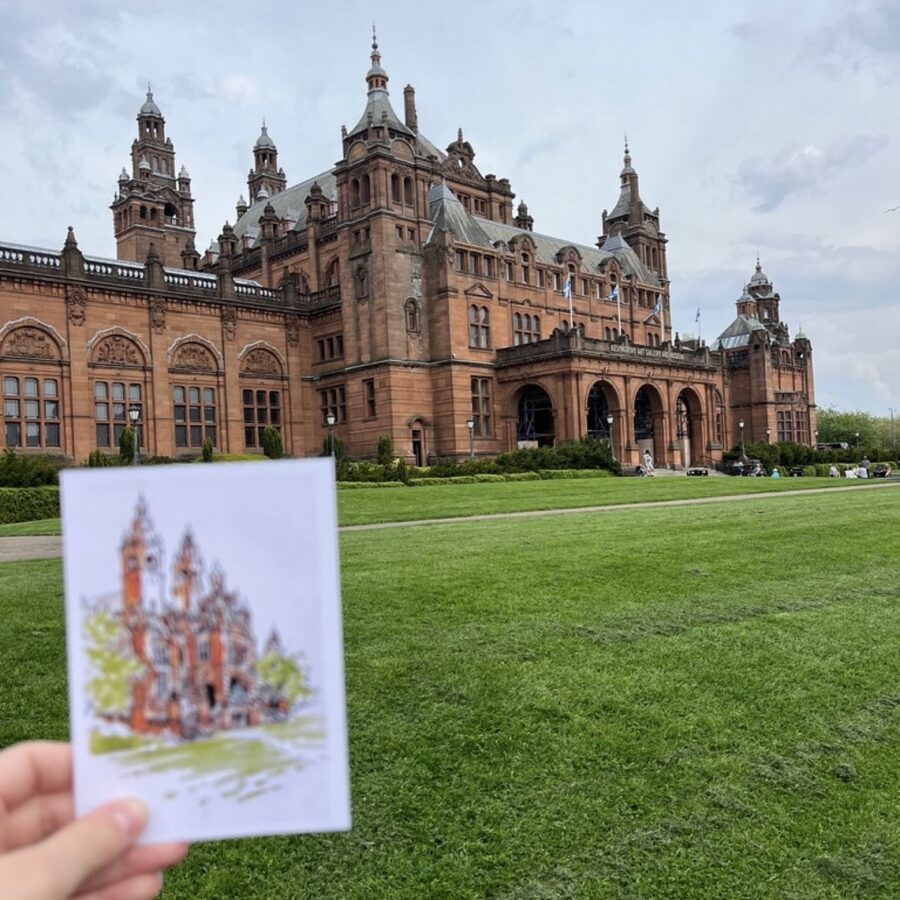
An International Student’s Perspective, by Madeline Wolfson
I am slightly embarrassed to say how long it took me to visit my first museum in Glasgow. It was months after getting settled into a new city across the world from home. In the US, I had grown accustomed to savouring my museum experiences due to costly ticket prices. I generally pushed visiting museums aside, only for special occasions, when friends or family visited.
I first discovered the Kelvingrove Museum on a rainy day after class. Upon entering, I was dazzled by the beauty of the space and the extensive array of exhibits covering all types of subject matter. I felt an overwhelming sense of calm, knowing I could return whenever I wanted, and that I could take my time with each exhibit. Not paying for a ticket took away the pressure of a museum visit, where in the past, I was overwhelmed by the feeling that I had to make it through every space to get the full worth of my ticket.
After my first visit to the Kelvingrove Museum, I now not only use the museums of Glasgow as places for viewing art and artifacts, but also as spaces I can stop off at, for a variety of reasons. I will head into the Burrell Collection and wander through the exhibits, or simply sit and read in one of the many open spaces. The lack of an entry cost to museums has made me return to them dozens of times, and I have used these spaces for a variety of purposes. An overarching feeling of comfort has followed me in these experiences, and as I built my sense of self and community, Glasgow Museums became part of my life in this new city. Free access made me fold museums into more of my day-to-day life. This change in my own understanding made me start to re-evaluate the purpose museums play in our lives, as visitors and as the residents of cities, and how museums can serve such greatly differing populations. It turns out that other visitors also felt similarly to me and that 82% of visitors reported that their time at Glasgow Museums made them feel a stronger connection to Glasgow (1). The British public also reported that an essential purpose of museums is to “inspire/stimulate, facilitate ‘discovery’, ‘share knowledge’ and provide information”, a purpose made even more crucial as British museums are generally seen to be “trustworthy unbiased sources of information” (2).
However, this is not such a simple conclusion to draw, and free museum access is much more complicated than these public polls might suggest. A MORI research paper found that although there is a substantial increase in the quantity of visitors when museum access is free, there is not necessarily an extension of the profile of visitors (3). They also explain that degree holders are four times more likely to visit British museums (3). I found these studies to be interesting supplements and extensions to my personal thoughts and experiences, highlighting that while free UK museums have brought in more visitors, they have not necessarily increased access for all groups of potential visitors. This has encouraged me to challenge the ease I feel in museum spaces, while also appreciating access and how it has helped me feel more at home in a new city.
Over time, I have grown to count on free access to museums as spaces that I can always enter and use, whether I simply want somewhere to sit or to wander inside during a cold winter day. They are also spaces where I have learned about history, for instance, through art exhibitions by iconic local artists like the Glasgow Boys and Girls, or even through seeing the images and materials of people’s lives long past at the People’s Palace. It has been amazing to gain entry to a history and culture that I never had a chance to learn about growing up. All together, my personal experiences with free access to museums in Glasgow (and the entirety of Britain), alongside the inequalities still clearly present in visitor statistics, tell a complicated story of the museum space. Despite this, I will always be grateful for what these spaces have become to me and the comfort and learning opportunities they have provided me in a city that has grown to be home.
Citations:
(1) “Head of Museums and Collections.” Glasgow Life, Saxton Bampfylde, July 2024, www.saxbam.com/wp-content/uploads/2024/07/GlasgowLife-Head-of-Museums-and-Collections-Appointment-Brief.pdf.
(2) “Public Perceptions of – and Attitudes to – the Purposes of Museums in Society.” Museums Association, BritianThinks, Mar. 2013, www.museumsassociation.org/app/uploads/2020/06/03042013-britain-thinks.pdf.
(3) Martin, Andy. “The Impact of Free Entry to Museums.” Head of Leisure Research, MORI, 2003, www.culturehive.co.uk/wp-content/uploads/2013/04/Impact-of-free-entry-to-museums-MORI.pdf.
Written for the Heritage Network Youth Forum by Madeline Wilson, Youth Forum member